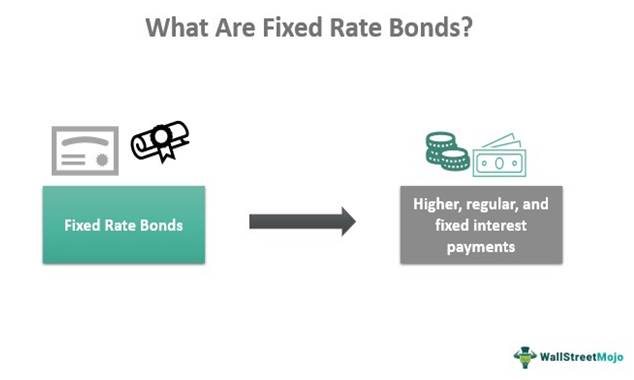Table Of Contents
Fixed Rate Bonds Definition
Fixed rate bonds (FRBs) refer to debt securities, offering regular and fixed interest or coupon payments until their maturity. The interest rate and the expiration date are agreed upon between the issuer and the investor. As a result, FRBs pay a higher interest rate than the rest of the investment accounts.
These bonds are appropriate for investors who do not wish to withdraw invested funds in the middle of the term or are looking for guaranteed returns on investments. Since yields are available at a fixed rate, these bonds are also considered fixed-income securities. Governments, private corporations, and other entities issue these bonds to raise funds for their operations.

Key Takeaways
- Fixed rate bonds (FRBs) are debt securities that pay a fixed interest rate or a coupon until they mature. The issuer and the investor agree on the interest rate and the expiration date.
- These bonds come in various maturities, including short-term and long-term, and have a lock-in term of one to five years.
- Investors receive their initial principle back from the issuer when a bond matures, along with interest payments made monthly, semi-annually, or annually.
- Examples of FRBs are certificates of deposits (CDs), treasury bills, treasury bonds, corporate bonds, asset-backed securities, municipal bonds, and preferred stocks.
Understanding Fixed Rate Bonds
Fixed rate bonds or securities provide investors with consistent and assured interest or coupon payments on investments over their maturity. People prefer investing in these bonds as the rates remain unaffected by even the worst market fluctuations. The coupon payments or preferred dividends depend on the borrower’s creditworthiness and existing interest rates. In addition, investors can invest in fixed-rate securities to diversify their portfolios. Furthermore, they protect the deposited amount.

These bonds are available with both short-term and long-term maturity. The lock-in period of fixed-income securities ranges from one to five years. Once investors invest in fixed rate securities, they cannot withdraw anything until the term expires or the amount matures. If they still do so, they are liable to pay a significant penalty.
At bond maturity, investors get their initial principal amount (or face value) back along with interest payments from the issuer. The fixed payment of interests can be monthly, semi-annually, or annually. Then, bondholders can withdraw, transfer, or reinvest those funds in access or another account, depending on the issuer.
Unlike floating or variable rate bonds, FRBs remain fixed and do not move up or down with the market or index. Hence, investors get the expected returns at the end of the tenure. As a result, these securities are suitable for those with a good understanding of investment-related risks.
Most of the bonds available in the market fall under the fixed-rate securities category, such as certificates of deposits (CD), treasury bills, treasury notes, treasury bonds, corporate bonds, asset-backed securities, municipal bonds, preferred stocks, etc.
Fixed-Rate Bond Risks
Fixed-rate securities offer a higher interest rate and better returns than easy access savings accounts. However, they come with a certain element of risks, such as:
- The longer the maturity period, the higher the interest rate, which results in significant yields but lowers the instrument value.
- With shorter maturity and lower interest rates, FRBs generate lower returns and pose lower investment risks.
- Inflation can greatly affect the value of fixed rate securities and purchasing power of coupon payments.
- Investors may face liquidity issues as the put-call spread widens.
Fixed Rate Bonds Examples
Let us look at the following fixed rate bonds examples to get a better understanding of the concept:
Example #1
Cyrus decided to invest in two financial instruments for two years – an easy access savings account and a fixed rate bond. Both of them were available to the holder at 4%. While the former was subject to market favorability, the latter had a fixed coupon rate resistant to market fluctuations.
As a result, Cyrus could plan his financial expenses with sure-shot returns on the fixed rate securities after two years. But he could not plan anything due to the uncertainties related to the easy access savings account.
Example #2
Fixed-income securities have appeared to be one of the best financial vehicles to invest in, given recent market fluctuations and the possibility of inflation throughout the world. FRBs are inflation-protected securities because their rates are fixed and unaffected by market conditions.
Recently, American Century has attempted to introduce a short-term, high-yield financial instrument via its new Multisector Income ETF. The company intends to make investments easier and rewarding for those who want a precise estimate of the long-term returns they could expect.
Example #3
Fixed rate bonds UK come with options for children with no minimum age limit. Plus, individuals without a current account can also open a “Re: Account” on behalf of someone else.
Banks and other financial institutions offer several fixed rate accounts in the UK. These investments remain protected by the Financial Service Compensation Scheme (FSCS). It provides coverage to up to £85,000 in savings at each financial institution. As a result, investors remain confident about getting their money back even if the institution fails to pay them.
Pros And Cons
Though a fixed rate bond offers several advantages over its alternatives, a few drawbacks lead some people to choose other options. In a nutshell, here are the benefits and disadvantages of these bonds:
| Pros | Cons |
|---|---|
| Fixed income through coupons | No withdrawal allowed before maturity |
| Resistant to market changes | Penalty for early withdrawal |
| Better interest rates than a protected savings account | Lack of flexibility |
| Exact returns are already known to bondholders | The risk of increased interest rates as a result of inflation, reducing the value of bonds |
